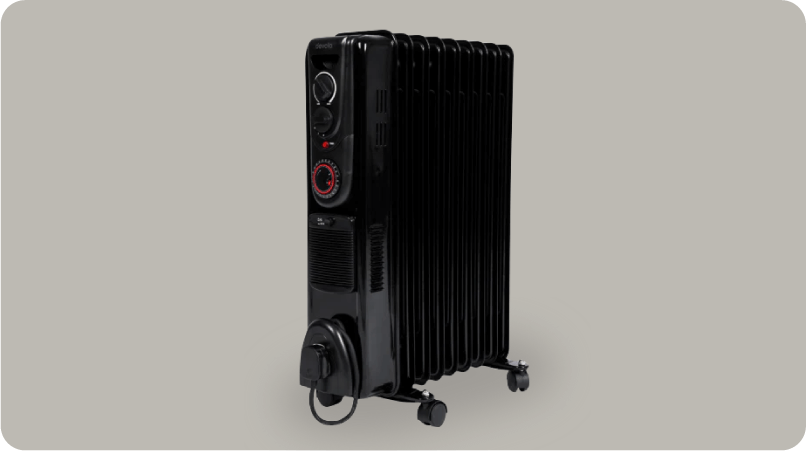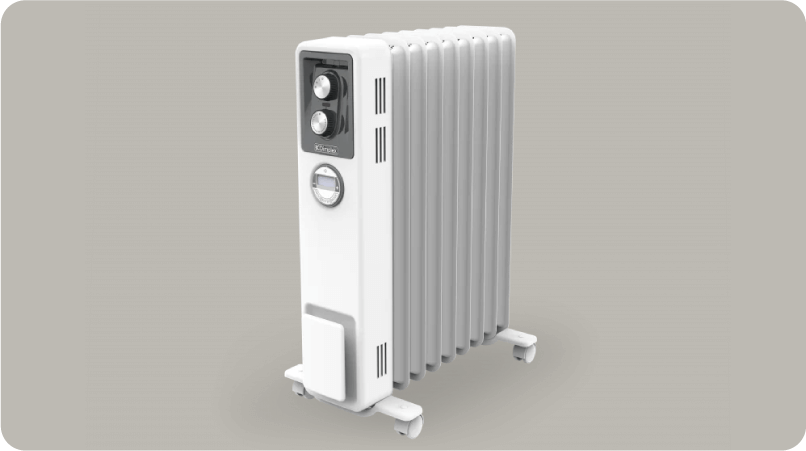When it comes to heating your home, making the right decision can be a challenge. With so many factors to consider like colour, long term use, and features — the choice between oil-filled and oil-free radiators can feel like a real conundrum. But worry not! In this article, we'll guide you through everything you need to know to make the perfect choice for you and your home.
- What's the difference and how do they work?
- Price/Cost of running
- Heating ability
- Features and Versatility
- Installation
- Long-term use
If you want to have a quick look, check out our handy chart:

What's the Difference and How Do They Work?
Oil Filled Radiators

They are a type of electric radiator that generates heat through a process of thermal fluid circulation (the fluid being oil, which is contained inside the radiator). The oil is heated up using an internal electrical element and then circulated around the appliance. This produces heat that is emitted from the radiator. The oil also retains heat for a long time after the appliance is switched off, making them more cost-effective to run.
Oil Free Radiators

Also known as dry thermal electric radiators, oil free radiators use electricity to generate the heat, but rather than warming up a fluid (oil) they heat up an element made of either aluminium or ceramic stone. The heat produced is then radiated throughout the surrounding space just like an oil-filled radiator.
Price/Cost of Running

You may be wondering about the costs and benefits of oil filled radiators and oil free radiators. An oil-free radiator is a popular choice for many homeowners, and it's no surprise why. These energy-efficient heating systems use electricity to generate heat through ceramic plates, resulting in less energy waste and lower running costs than their oil-filled counterparts. While oil-filled radiators provide longer-lasting heat, they require more electricity to do so, making them more costly to operate.
When weighing up the costs, it's important to consider factors such as your usage patterns and the size of the area you need to heat, as this can affect the efficiency of both types of radiators.
Heating Ability

Oil filled radiators are a popular choice for their ability to provide long lasting heat in a reliable and efficient manner. A key reason for their effectiveness is their optimum heat retention, which means that they continue to radiate warmth even after being turned off. The oil within the radiator is a conductor which heats up quickly and emits a consistent, even heat distribution throughout the room. Unlike traditional convection heaters, these radiators do not rely on continuously heating the air to warm a space, thereby providing a more comfortable and less stuffy environment. Overall, oil filled radiators are a smart choice for anyone seeking a cost effective and efficient way to heat their home.
Oil Free radiators are incredibly efficient when it comes to heating large spaces, such as high-ceiling properties. They can raise room temperatures with minimal effort, and the heat they generate is quick to spread throughout the room evenly. Aluminium dry thermal electric radiators, unlike oil-filled heaters, offer rapid heat-up and cool-down times. This makes them highly responsive to your commands, ensuring effortless control over the desired temperature.
Features and Versatility

When purchasing an electric radiator, it’s important to consider certain features to enhance your experience. Look for a radiator with an adjustable heating dial and a programmable / 24-hour timer, which will save you money by only heating up when you need it.
Safety should likewise be a top priority. Look for a radiator that includes a tip over sensor, which automatically stops heating if knocked over and an automatic shut-off switch to prevent overheating. This makes them ideal for homes with children and/or pets.
Additionally, look for a radiator with an IP rating and overheat protection for added safety measures.
Finally, these radiators offer exceptional portability, and selecting a model with smooth-gliding casters ensures effortless movement from one room to another.
Installation
Installing both radiators is very straightforward with no need for complicated pipes or plumbing. Just unpack the radiator, plug it into a nearby socket, and you're good to go. If you put it on castors, you can easily move the radiator from one room to another, placing them wherever you need the most warmth in your home.
Long-term use
Oil filled and oil free electric radiators are designed to last for many years, and with a periodical clean the unit by gently wiping it down, they can continue to function effectively and efficiently for an exceptionally long time. So, if you are looking for an efficient way to heat your home for many winters to come, an oil-filled or oil free radiator is certainly worth considering.
Oil filled radiators are the champions of efficiency and cost-effectiveness in the long run. They might be a bit heavier, but they boast amazing features like a 24hr shutdown memory function, adjustable heating dials, and tip over sensors. On the flip side, if you prioritize energy-efficiency and eco-friendliness, oil free radiators are the way to go. These lightweight and portable heaters come with nifty perks like programmable timers and automatic shut-off switches to save energy.
Ultimately, the choice between oil filled and oil free radiators depends on your individual needs and preferences. Both types provide a reliable source of heating for your home, so it's important to consider all aspects before deciding.
Want to learn more about air conditioners? Check out our other articles:








 Desk Fans
Desk Fans
 Pedestal Fans
Pedestal Fans
 Floor Fans
Floor Fans
 Tower Fans
Tower Fans
 DC Fans
DC Fans
 Air Circulators
Air Circulators
 Portable Air Conditioners
Portable Air Conditioners
 Evaporative Air Coolers
Evaporative Air Coolers
 Wall Mounted Air Conditioning Units
Wall Mounted Air Conditioning Units
 Commercial Cooling
Commercial Cooling
 Ceiling Cassette Air Conditioning
Ceiling Cassette Air Conditioning
 Home Dehumidifiers
Home Dehumidifiers
 Drying Clothes Dehumidifiers
Drying Clothes Dehumidifiers
 Low Energy Dehumidifiers
Low Energy Dehumidifiers
 Compressor Dehumidifiers
Compressor Dehumidifiers
 Desiccant Dehumidifiers
Desiccant Dehumidifiers
 Commercial Dehumidifiers
Commercial Dehumidifiers
 Wall Mounted Dehumidifiers
Wall Mounted Dehumidifiers
 Dehumidifier Accessories
Dehumidifier Accessories
 Humidifiers & Air Purifiers
Humidifiers & Air Purifiers
 Inline Fans
Inline Fans
 Kitchen Extractor Fans
Kitchen Extractor Fans
 Bathroom Extractor Fans
Bathroom Extractor Fans
 Commercial Extractor Fans
Commercial Extractor Fans
 Shower Extractor Fans
Shower Extractor Fans
 Silent Extractor Fans
Silent Extractor Fans
 Heat Recovery Extractor Fans
Heat Recovery Extractor Fans
 PIV & Whole House Ventilation
PIV & Whole House Ventilation
 Extractor Fan Accessories
Extractor Fan Accessories
 Extractor Fan Controllers
Extractor Fan Controllers
 Panel Heaters
Panel Heaters
 Fan Heaters
Fan Heaters
 Patio Heaters
Patio Heaters
 Storage Heaters
Storage Heaters
 Towel Rails
Towel Rails
 Underfloor Heating
Underfloor Heating



 Electric Fires
Electric Fires
 Time Controllers
Time Controllers
 Ducting Kits
Ducting Kits
 Internal Grilles
Internal Grilles
 External Grilles
External Grilles
 Ducting Hose
Ducting Hose
 Ducting Clamps
Ducting Clamps
 Ducting Connectors
Ducting Connectors

 Electric Radiators
Electric Radiators
 Oil Filled Radiators
Oil Filled Radiators
 Oil Free Radiators
Oil Free Radiators
 Designer Radiators
Designer Radiators
 Water Boilers
Water Boilers
 Under Sink Water Heaters
Under Sink Water Heaters
 Over Sink Water Heaters
Over Sink Water Heaters
 Unvented Water Heaters
Unvented Water Heaters
 Instant Water Heaters
Instant Water Heaters
 Boiling Water Taps
Boiling Water Taps
 Hand Wash Units
Hand Wash Units
 Air Curtains
Air Curtains
 Returned Air Conditioners
Returned Air Conditioners
 Returned Fans
Returned Fans
 Returned Dehumidifiers
Returned Dehumidifiers
 Returned Heaters
Returned Heaters




